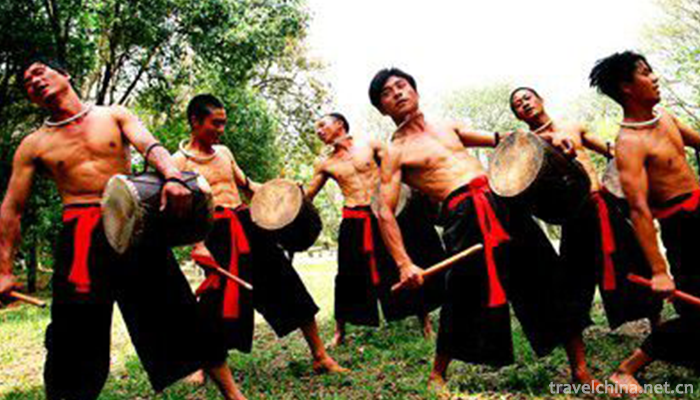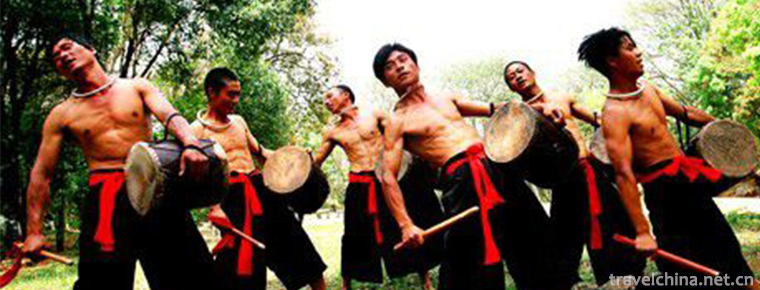Drum dance
Drum dance
Hani rhythm and drum dance is a kind of sacrificial dance of Hani people on the traditional festival "Onmatu". The dance is vigorous and bold, vigorous, simple and free, showing the same personality as the Hani People's Mountain and the same feelings as the forest. The rhythm and drum inspiration originated in the ancient times when the Hani people lived by hunting.
In November 2014, the handcuffs and drums declared by Jianshui County of Yunnan Province were listed in the fourth batch of national intangible cultural heritage list with the approval of the State Council.
historical origin
In order to contact and invite hunters during hunting, people inadvertently found that the hollow trees in the mountains would make a noise, so they cut hollow logs and stretched the cowhide to make drums. In addition to contacting and inviting hunters, drums can also play a role of attracting prey by tapping gently sometimes. If a single person or a small number of people encounter a beast, stormy beating can also play the role of self-defense of the beast running under the mouth.
The simple, deep, dignified, rhythmic and mysterious dance moves the audience's thoughts to the ancient Hani tribe, witnessing the heroic struggle between the Hani ancestors and nature. With the development of society, they imitated the farming action of agricultural production, which made the rhythm inspiration develop abundantly. Especially the discovery and utilization of copper began to have the rhythm inspiration, which became the real rhythm inspiration. Handcuffs represent the fullness of millet and drums represent the abundance of millet grains. Now, handcuffs and drums are the main activities to pray for a full crop, a good harvest of grain or to celebrate festivals and festivals.
Especially the Hani people's traditional ritual of "sacrificing dragons" which prays for good weather and good luck is inseparable from the rhythm and drum. They always carry the rhythm and drum through the whole process. Every festival, Hani set up a rhythm drum farm in the forest, singing a long narrative song of "Haba" in memory of their ancestors'achievements, dancing rough and vigorous, reflecting the ancient social life of the Hani people and the arduous encouragement of digging terraces. When dancing, first of all, the prestigious and respectful elders elected to preside over the opening ceremony, toast on gongs and drums, hold handcuffs around the table three times, salute to the four directions, and then knock the gongs three times to show the beginning. Afterwards, the dancer holds the handcuffed drum, beats and dances, forms a circle, the drum beater is outside, the handcuffer is in the center. When dancing, the center of gravity of the body moves down, the legs continue to flex and stretch, and the body fluctuates up and down. At this time, Hani women are standing hand in hand in two lines, dancing a simple, deep, vigorous, rigid and soft dance. The whole dance is simple and vigorous, deep and powerful, novel in rhythm and enthusiastic and unrestrained, which makes people feel a kind of male masculinity beauty, and vividly reflects the Hani people's strong and simple character and perseverance of the national spirit.
Inheritance significance
Haniduo Drum Encouragement was once praised as "the art of world style". It was praised at the opening and closing ceremonies of the National Minority Sports Games and the Third China Art Festival for its touching power. He won the highest prize in the Chinese Encouragement Competition held in the capital, the Shanhua Prize. The rhythm and drum show the great national character of the Hani people's ancestors, who are persistent, persevering, united and struggling, breaking through all difficulties and dangers, and heading for the ideal goal. The drum dance is one of the important heritage of Hani's ancient culture. It is not only the essence of Hani dance, but also has important value for studying Hani's history and the prosperity of today's national dance art.


-
1.The ancient city of Qingzhou
Qingzhou ancient city is one of the ancient nine states. It has a history of more than 7,000 years, a history of civilization of more than 5,000 years
Time 2018-12-08 -
2.Pavilion of Prince TengTengwang pavilion
Tengwang Pavilion, one of the three famous buildings in the south of the Yangtze River, is located on the East Bank of Ganjiang River along the Yangtze River Road in the northwest of Nanchang City, Ji
Time 2018-12-08 -
3.Chongqing Yunyang Longgang National Geological Park
Yunyang Longgang Scenic Spot: National AAAAA Class Tourist Spot, National Geopark and National Day 2016 "Best Tourist Service Scenic Spot"
Time 2018-12-12 -
4.The Yellow Dragon Cave huanglong Cave
Located in Wulingyuan Scenic Area, the core scenic spot of Zhangjiajie City, Hunan Province, Huanglong Cave is an integral part of the World Natural Heritage Site and Zhangjiajie World Geopark
Time 2019-01-18 -
5.Qingxiushan Mountain
Qingxiushan Scenic Area is a national AAAAA scenic spot in Nanning. Qingxiu Mountain is a key scenic spot in Nanning. In addition to protecting and restoring the original historic sites
Time 2019-02-07 -
6.Shenzhen Maritime Pastoral
Shenzhen Maritime Pastoral Tourist Area is administratively located in Shajing Street, Baoan District, Shenzhen City. It is located at the eastern port of Pearl River estuary
Time 2019-02-08 -
7.Eight treasures quail
Babao quail is a dish. Its main ingredient is pure quail, etc. Its ingredients are purple quail, lotus seed, etc. Its seasoning is peanut oil, salt, soy sauce and so on. It is made by deep-frying.
Time 2019-03-25 -
8.Handmade Paper Making Skills of Dai and Naxi Nationalities
Dai and Naxi hand-made paper-making skills, Yunnan Lincang City, Shangri-la County, local traditional handicraft, one of the national intangible cultural heritage.
Time 2019-04-24 -
9.Printing and Dyeing Techniques of Blue Printed Cloth
The printing and dyeing technology of blue printed cloth is a kind of anti-dyeing and printing method of indigo printed cloth. The dye is extracted from Polygonum multiflorum.
Time 2019-05-11 -
10.Construction Techniques of Traditional Residential Buildings in Southern Fujian
South Fujian residential building technology is a unique traditional architectural technology originating in Quanzhou, which began in Tang and Five Dynasties, is the mainstream of ancient architectura
Time 2019-06-05 -
11.Nazikum
Nazikum is a folk dance performance that combines instrumental performance, competitive performance, mime performance and rap. The unique squatting dance is the leading style in Uygur folk songs and d
Time 2019-06-07 -
12.lion dance
Lion dance, also known as "Lion Dance", "Lion Lantern", "Lion Dance", "Lion Dance", "Lion Dance", is one of the folk dances of all ethnic groups in Ch
Time 2019-06-14